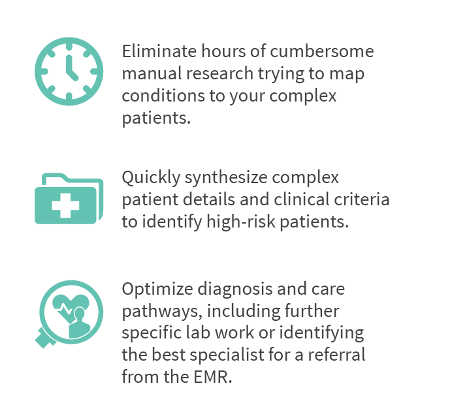
Every primary care physician has a rare disease patient, whether they know it or not. In fact, primary care physicians likely have many. However, it’s challenging to identify and diagnose these patients as it is nearly impossible to know about every rare condition.
In honour of the recent Rare Disease Day, we are shining a light on those conditions and looking at a platform that helps physicians diagnose and treat patients with rare diseases.
What is Rare Disease Day?
Rare Disease Day is a globally coordinated movement that seeks to raise awareness of rare diseases and improve access to diagnosis and treatment for those impacted by them.
Founded in 2008, Rare Disease Day shines a light on the lives of 300 million people across the globe who suffer from more than 7000 rare diseases. On February 28th each year, an international community joins together to “share their colours” to raise awareness and advocate for change.
What is a rare disease?
To be classified as a rare disease, a condition must affect fewer than 1 in 2000 people. Around 80% of these diseases are genetic, and more than 50% of patients diagnosed are children.
Of the over 7000 known rare diseases, only 5% currently have an available therapy. This means that these diseases are not only rare but often chronic and life-threatening, with 30% of children with rare diseases dying before their fifth birthday.
How many people in Canada are affected by rare diseases?
Around 1 in 12 Canadians are affected by rare diseases, and in Canada, two-thirds of those are children. When discussing conditions with low prevalence, this number can seem surprising!
However, while each rare disease is low prevalence, the total number of rare diseases is 7000 and counting. As a result, up to 2.8 million Canadians are affected. And with so many children diagnosed, this also impacts entire families.
So, while each rare disease is rare, it is common to be affected by rare diseases.
According to the Canadian Organization for Rare Disorders (CORD), only 60% of treatments for rare disorders become authorized and make it into Canada, and most get approved up to 6 years later than Europe and the USA. All of this combines to represent a substantial burden on the Canadian healthcare system.
What makes rare diseases so difficult to diagnose?
The low prevalence of rare disorders and the way they can have seemingly disconnected effects on multiple body systems are both factors.
Each rare disease may also impact only a small number of Canadians. In addition, the range of symptoms is broad, and often common symptoms can hide rare diseases. This combination makes it difficult for primary care physicians to identify them. In fact, there are so many rare diseases it makes becoming familiar with them or knowing how to get the support necessary to make an early diagnosis very challenging.
CORD also suggests that “understanding and expertise may be limited and fragmented across the country.” In other words, rare disease specialists may be hard to find or unavailable locally, leading to long wait times.
These factors contribute to a lengthy diagnosis process, frequently taking up to 5 years. In that time, patients visit on average 8 physicians and receive 2 to 3 misdiagnoses before being accurately diagnosed.
For patients, this can make the process of getting an accurate diagnosis stressful and challenging, especially for the children and families impacted by a rare disease.
What support is available to physicians to help diagnose rare diseases?
Raising awareness of rare diseases is vital. It helps everyone – including physicians – better understand the issues and help drive change. It is also crucial to provide support to physicians in screening and moving the patient along the appropriate care pathway.
Thankfully, this is where newly available technology can help!
Khure Health puts the power to identify and assess patients with rare diseases in the hands of physicians. Khure’s platform streamlines rare disease diagnosis by rapidly identifying patients potentially at-risk of rare conditions using pathology-specific AI algorithms based on available clinical guidelines and expert specialist input.
“It’s like having a rare disease specialist at your fingertips.”
– Dr. Nadia Alam, Family Physician & Past President of the Ontario Medical Association

This screening process takes just minutes to match patients to rare disease clinical criteria and provides guidance on the correct care pathway, including identifying appropriate referrals/labs and active clinical trials. The platform is free for physicians to use and qualifies for a training honorarium for clinical reviews conducted with their clinical specialist team.

Other key features of the Khure Health platform include,
- Patient identification for clinical trials research
- Accredited education programs
Join in the fight against rare diseases!
Physicians have used Khure Health’s clinical intelligence platform to conduct millions of screenings of high-risk patients. Uncover your high-risk patients and put them on the right care pathway. Participation is easy, at no cost to you, and takes just a few simple steps.
To get started, visit the Khure Health profile on apps.health.




